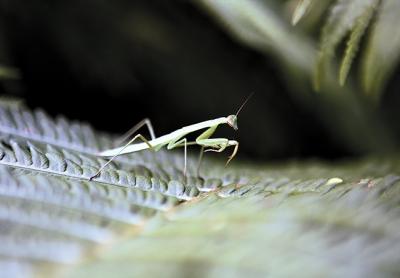Nature Notes: Night Stings, Insect Prayers

In June, early summer days were dominated by the songs and call notes of birds with high testosterone levels. Some humans lucky enough to live in Promised Land on Napeague or on Fort Pond Bay near Navy Road in Montauk, where whippoorwills still breed every summer, heard birdsongs during the day and at night. July was the hottest month yet and a transitional period: Birds became silent, insects began to dominate the dark hours with their mating songs.
On July 27 in the trees outside the old schoolhouse in Noyac, the snowy tree crickets made their debut. It was about 8 p.m., our Noyac Citizens Advisory Committee meeting had ended, our secretary, Sherry Kiselyak, and a member, John Anderson, and I were talking about summer night activities when we were kids, when all of a sudden we were bombarded on all sides by the charging notes of tree crickets overhead. They would sing for about 30 seconds as loud as can be, then go quiet for a minute or so.
This was the beginning of their ode to August. On Thursday morning they were back at it, like a symphony orchestra tuning up before a concert, but singing in full daylight, with the same gusto, punctuated in short bursts interrupted by longer silences. I gathered that the males were testing out the stridulatory edges of their wings to see if they were in proper condition for two months of night-after-night concerts without a day off.
It was 9:30 Monday evening, pitch dark, and I was listening with an amplified receiver and earphones. The katydids were going at it on center stage, the snowy tree crickets, trilling in the background. How wonderful! It is, in my mind, the best part of summer. There are those from urban areas who would feel more comfortable surrounded by honks, sirens, and radio music; the chorusing out here that I love so much would keep them awake at night. And if you lack a thermometer, you can figure out the air temperature in Fahrenheit within a degree by counting the number of pulses in 15 seconds and then adding that number to 40 according to Dolbear’s Law, formulated in 1897.
In August the insects hold sway. The gypsy moth males have found their non-flying mates; eggs have been laid on the barks of trees. The southern pine borers continue to ravage the Long Island pine barrens. Mosquitoes buzz you if you stand still outside in the dark. Lots of other insects somehow make it into your house if you leave the lights on.
But it is also a time for butterflies, not the same old cabbage moths, but tiger swallowtails and the like. It is time for the most bizarre looking insectsof all, the walking stick and the praying mantis. One very rarely sees more than one or two of these, the largest of our creepy-crawlies, in a season.
The walking sticks are so well camouflaged as they perch on a branch that you could walk by one, almost touch it with your nose, and not see it. The mantis is much more obvious as it stands stiffly half upright on a twig or plant stem, often for minute after minute, holding forelimbs just under its head, which turns and looks at you the way an owl can, without moving its body.
Mantids come in green or brown, are up to four inches long, and have eyes that can move independently to look at two different objects at the same time. In this way they keep one eye out for predators — birds, squirrels and the like — and the other out for prey. Males are much better fliers than females. They can fly to their prey — tree crickets, beetles, grasshoppers, spiders — while the female is mostly a stalker, stealthily walking along a branch with prey fixed in her sights, and then, quicker than your eye can detect, grabbing it with her forelegs.
Mantis comes from the Greek for “prophet.” Our local praying mantises came originally from either China or Europe; they were imported in the 1890s to combat the gypsy moths, another foreigner, which was just beginning to burst out in damaging form. It was a doomed experiment. Most such introductions are. There are never enough of the former to counter the outbreaks of the latter. Anyway, a female praying mantis would just as soon eat her mate as any other insect, but only after insemination. One fewer mantis to contend with is the idea.
After copulation, the female bulges with eggs, making her heavier than ever and preventing any sort of escape flight if she is attacked by a predatory bird or mammal. She lays her eggs in a foamy ecru mass on the branch of a tree or shrub, say a black cherry or beach plum. The eggs make it through the cold of winter and hatch in early spring into nymphs, which immediately get started hawking prey until molting produces a larger nymph. More eating, and yet a larger nymph, and so on and so on until an adult molts its final nymphal skin come late May or June.
On the other hand, catch a newly emergent praying mantis and put it in your flower garden. It won’t get every harmful insect, but it will stay around for the rest of summer and you will enjoy its presence. While you look at it, it will look at you.
Larry Penny can be reached via email at [email protected].
